Mission Beach to Townsville (and some more diving)
Monday, September 21, 2009
 Townsville, Queensland, Australia
Townsville, Queensland, Australia
We packed up our van and set off, pausing only to view the Big Cassowary in South Mission and find the road called Webb Road that Jen thinks is so unique . We were on our way to Townsville, where we had arranged some diving on the wreck of the SS Yongala, reputed to be one of the best wreck dives in the world. We had already stayed in the town before so wanted to make a ‘flying visit’, arranging to stay at a campsite we knew, by the shore and relatively close to The Strand (Townsville's main seafront road and evening gathering place).
On the way we noticed (and heeded) lots of the Cassowary warning signs but did not see any cassowaries. The signs are a bit curious because they seem to show that a collision with one of these birds seems to rock the poor character back on his heels but he remains intact. On the other hand, the car appears to be much worse affected with substantial damage to body and to glass!
We called into Rollingstone en-route to search for the camping area that we had been unable to locate on the way up. It was clear why, when we realised that it was actually some way off the main highway . It was a quiet and pleasant stopping place beside a creek with a swimming hole, which claims to allow up to 48 hours camping without charge. However, we talked to a hairy motorcyclist there who says that the rangers are not really concerned provided you are quiet and keep your site clean and tidy. He waxed lyrical about all the places he has stayed in when going out with his Harley Davison club. He was particularly impressed with camping in the grounds of a bush pub on the road to Cookstown which, he felt, must be ‘at least a hundred years old’ (we think he means the Lion’s Den, built in 1875 and made of corrugated iron - just a small point but surely this will have been replaced several times during its life?)
The Rollingstone rest area facilities are dedicated to Vincent ‘Bushy’ Parker, an Englishman who emigrated to Oz but later served in the RAF and was shot down in Europe. As a multiple escaper from prison camps, he was transferred to Colditz and warrants a reference in the Colditz story as a locksmith . After the war he continued to live in England but the toilet block here is now decorated with murals of important moments in his life. Another feature is the ‘Rollingstone railway station‘. This was originally the Armidale station but was relocated here and renamed, where the railway never went. Or rather, a small part of the station has been relocated, much is not here at all. Just to make it authentic, some sleepers have been laid on the ground to show where the railway would have been, if it had ever been there. Accompanying the railway station were several different war memorials, including one designed to hold all the names of each of the sons of Rollingstone from each of the services; so far they have found four.
We resisted the temptation of this peaceful and free campsite as we needed to be at Townsville Marina at 7am the next morning to meet our dive boat. We headed off once again, found our site in Rowes Bay, got settled in and took a walk along the seafront to re-visit Harold’s for fish and chips! Sunset across the bay was beautiful and we saw a little of the residential area as we detoured around the military museum (which occupies the headland and refuses access to the seafront) to join The Strand . This seafront area, as usual, was a hive of activity in the early evening. Although it is warm well into the evening it always becomes dark, very suddenly, at 6.30 pm in Oz and we still find it quite strange, but very appealing, that people are out picnicking and BBQ-ing in the dark by the seafront!
Fish and chips eaten, we headed back for an early night in preparation for our Yongala dive trip the next day. The Yongala was a passenger ship which sank during a cyclone in 1911 and all 121 people on board were lost. Interestingly, at the time the baby was not included in the passenger list, so people keep adding one for the baby when they tell the story. However, sometimes the text has already included the baby so the number keeps increasing and the most we’ve heard so far is 124. The only body that washed up was that of Moonshine, a racehorse that had been onboard . The wreck itself was not found until the 1950s and bodies have been found within it. It is therefore considered a marine grave and divers are not allowed to actually penetrate the wreck . However, it is an absolutely fabulous dive. The Yongala is in a remote location and has become a reef as hordes of corals have taken a hold and other creatures have begun to gather there. The wreck is the only reef structure in the area, so lots of marine life gathers here. There is an amazing range of soft corals living all over the vessel. Everything is big. Big fish, big schools, big wreck! We saw huge numbers of Giant Trevalleys, several sea snakes, turtles and a big grouper being cleaned by cleaner wrasses. Unfortunately the camera has decided to stop talking to the flash unit and we were not able to get any usable underwater pictures (although there is a good picture of Tony on the boat trying desperately to fix the problem and Jenny noticed a cloud shaped like a fish!)
The most amazing thing, and the highlight of all our diving in Oz, was on the second dive. Due to the strong currents at this site, we descended down a line to the stern of the wreck, in order not to drift away and miss the wreck altogether . As we reached the wreck, there was a huge Manta Ray, well over two metres wide, hanging around about a metre away from us! It just hovered there at the side of us, watching us as we watched it! It was so elegant and did not seem bothered by us at all and was not at all threatening. This must be one of the most amazing experiences of our whole dive careers! It was tempting to stay here for the whole dive but after hanging around for a while watching it we eventually moved on, finning against the current down to the other end of the boat. At times the current was so strong that it felt as though we were putting in all of our energy just not to get swept backwards. Eventually we made it to the prow and then were able to just relax and enjoy the drift back to the stern. Back at the stern, the Manta Ray was still there and we hovered around again whilst he/she even took a gentle swim around us to observe us from different angles! Luckily we still had a bit of air to spare to allow us to just hang and watch. What an amazing experience it was! We both agrred that this was one of our favourite dives ever!
Other Entries
Comments
2025-05-22
Comment code: Ask author if the code is blank

 Townsville, Queensland, Australia
Townsville, Queensland, Australia
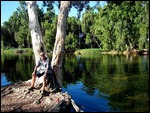

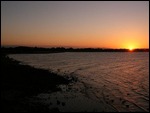
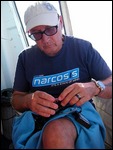






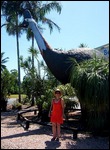

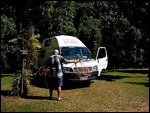

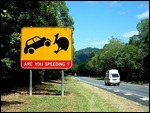

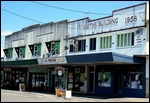
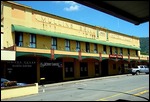
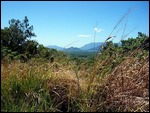
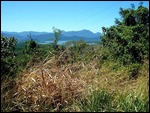

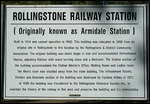
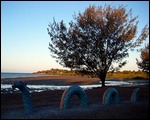
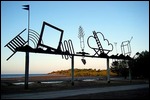
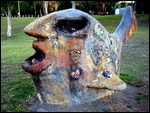
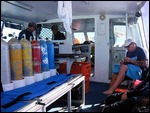
Karl
2009-11-04
Wow impressive! you really made townsville look better! you should have been up castle hill and seen the war bunkers and gone to the RAAF museum! You would have enjoyed it!
jenandtony
2009-11-04
This was our second visit to Townsville (see our blog No 29, where we do show a bit more of the town) but we didn't go to the RAAF museum, there always seemed something else to do!